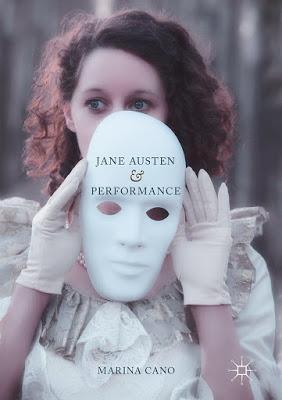 Dr Marina Cano has just published a very interesting study of Austen’s work and its afterlives. One chapter is dedicated to Jane Austen Fans; that is why I heard of Marina and her research before the book came out. She contacted me for her survey: am I not a truly devoted Austen fan who has the luck and joy to know a lot of truly devoted Austen fans?
Dr Marina Cano has just published a very interesting study of Austen’s work and its afterlives. One chapter is dedicated to Jane Austen Fans; that is why I heard of Marina and her research before the book came out. She contacted me for her survey: am I not a truly devoted Austen fan who has the luck and joy to know a lot of truly devoted Austen fans? I’m truly glad now to present the final work, Jane Austen and Performance, and to introduce Dr Marina Cano to you and let you discover more about her research in her own words. She took some time to answer some questions and here’s the resulting interview.
When and How did you discover Jane Austen?Like many of the fans who so generously answered my survey, I came to Austen through the film adaptations. In my case, it was Ang Lee’s Sense and Sensibility (1995)—with Emma Thompson, Kate Winslet, etc.—that made the trick. From there, I went to the novels—and more films!—Pride and Prejudice, Persuasion...And the rest is history!How do you explain her being the most beloved author in English Literature?This is the ultimate question I try to address in my book Jane Austen and Performance: I examine the “performative potential” behind her texts—in other words, her ability to make things happen. Readers “perform” her novels and her stories; they inhabit her characters on every reading, or every time they watch one of the film or stage adaptations, or revisit her stories in any way. And this does have an effect on people’s lives; it changes things, as so many of the wonderful respondents to my survey made clear. It might happen to some extent with other authors but not as much; I think it is what makes Jane Austen so special in English literature.
Could you explain the title of your work to our readers, please?In Jane Austen and Performance, I look at plays and sketches based on Austen’s stories, but also at other “performances” that do not necessarily take place onstage. Some of these are part of our everyday life and occur, for instance, every time a Janeite compares her family members with an Austen character, as several of the respondents to my survey said they do! So I’m interested in how we readers “perform” or engage with the novels—be it through fanfiction, Regency balls, sequels, films, radio adaptations and so on. What did you discover in your survey among Austen fans? First of all, the incredible generosity of Austen fans—this is something many of my respondents pointed out about the Austen community at large—but I was really, really touched when so many people devoted an important amount of their time to giving me detailed explanations of what Austen means for them and how her work has influenced their lives. I also discovered the power of Austen to bring so many different people together: people from very different countries, ages, backgrounds and professions answered my survey—from 15 to 80 years of age, from the US to Russia, from English teachers to nurses and engineers. I think this power to connect, rather than divide, people is very much needed currently. So perhaps reading a bit more Austen is after all part of the solution to all our current political problems in the West!
One of the chapters in your book is Jane Austen Abroad. We know that Austenite are a worldwide community. Have you discovered any new or not very well-known Austen reading community?This chapter is very dear to my heart: it mostly examines Austen in Scotland. So “abroad” here means outside of England, Austen’s native country. It also discusses Austen in South Dakota (US), Russia and Germany. As a whole, my book follows the chronological developments of Austen’s reception in the West, and the Chapter “Jane Austen Abroad” deals with the 1940s and 1950s in particular. I lived in Scotland for a long time, and I discovered a wealth of material on Austen theatrical performances that seemed to have gone noticed. What I found particularly fascinating while working on this chapter was how Austen had been appropriated by the Scots in the 1940s and 1950s, to the point of becoming Scottishisised—more on that and Catherine Morland’s tartan dress in my Chapter 6.
Among Jane Austen’s major novels, which one do you consider her most “modern” piece of fiction? Why?I have to say Persuasion here: for its defence of women’s rights, its strong heroine, its more relaxed class system and the unusual (for Austen) ambiguity of its ending. Have I persuased you? Well, it is also my favorite Austen, so perhaps I’m biased!Well, Persuasion, is my favorite Austen too, so I totally agree with you. That’s all for now. Thanks a lot for being my guest today, Marina. I would like to express my deepest gratitude to everyone who took part in my Austen survey in March 2015 and to you, Maria Grazia, for your generous help and for having me here today. I have a request for you and your readers: for my next project, I’m looking for improvised performances of Austen and Shakespeare respectively, or connected to these authors—of the type of “Austentatious.” If you know of any other, please contact me at [email protected]. Thank you!About the BookJane Austen and Performance is the first exploration of the performative and theatrical force of Austen’s work and its afterlife, from the nineteenth century to the present. It unearths new and little-known Austen materials: from suffragette novels and pageants to school and amateur theatricals, passing through mid-twentieth-century representations in Scotland and America. The book concludes with an examination of Austen fandom based on an online survey conducted by the author, which elicited over 300 responses from fans across the globe. Through the lens of performative theory, this volume explores how Austen, her work and its afterlives, have aided the formation of collective and personal identity; how they have helped bring people together across the generations; and how they have had key psychological, pedagogical and therapeutic functions for an ever growing audience. Ultimately, this book explains why Austen remains the most beloved author in English Literature.
About the Author
Dr Marina Canois a teaching fellow in Women’s Writing in English at the University of Limerick, Ireland. Her research interests include women’s writing, the long nineteenth-century, performance and gender theory. She is also a researcher in “Travelling Texts 1790-1914: Transnational Reception of Women’s Writing at the Fringes of Europe.”Giveaway

